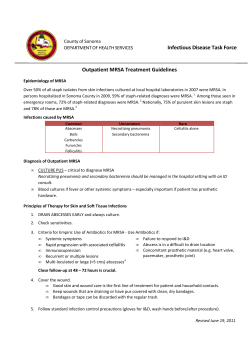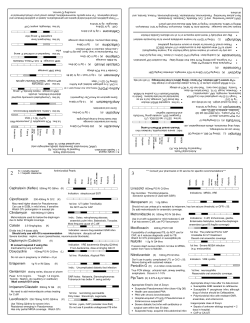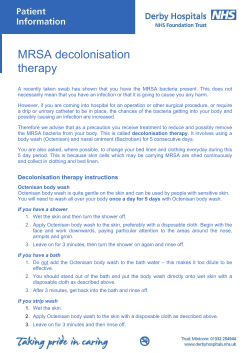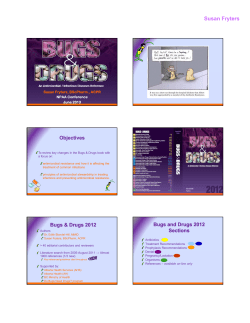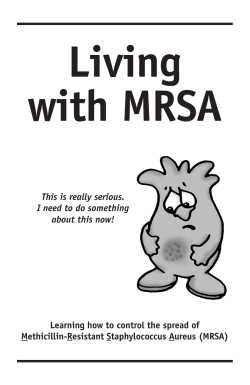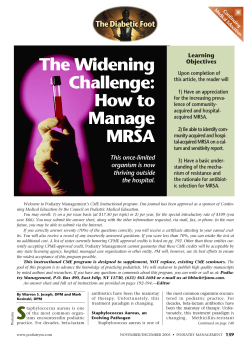
MRSA: A Resource Manual for Nurses
MRSA: A Resource Manual for Nurses and other Healthcare Workers in Acute Care Settings Developed by: Amanda Whelan, Whelan, MN, BN, BN, RN & Donna Moralejo, Moralejo, PhD, RN Memorial University School of Nursing Endorsed by: Provincial Infection Control Newfoundland Newfoundland Labrador (PIC(PIC-NL) November 2011 Who is this resource manual for and Why? Are you a new nurse and not sure how to put a patient on Contact Precautions? Or perhaps you’re an experienced nurse dealing with MRSA for the first time in a long time. Maybe you just want to know what the difference between colonization and infection with MRSA is. This manual has been developed for nurses but may be useful for all healthcare workers. Many of us figure we know enough about MRSA, but do you really? There are a lot of myths and misinformation surrounding MRSA. Test yourself! Are the following statements true or false? Turn to page 4 for the answers, and refer to the different sections in this resource manual (listed on page 5) to learn more about MRSA and caring for patients with MRSA. MYTHS AND MISINFORMATION Are the following statements true or false? 1. All nurses are MRSA positive. 2. I don’t need to wear gloves when checking the blood pressure of a patient with MRSA. 3. Nurses always clean their hands properly. 4. It’s only MRSA, the doctor will order some antibiotics and it will be gone. 5. It takes too much time and effort to put on gloves and a gown. IF YOU THOUGHT THE STATEMENTS WERE TRUE, THEN THIS MANUAL IS FOR YOU! IS ANOTHER RESOURCE MANUAL ON INFECTION PREVENTION AND CONTROL NECESSARY? Methicillin-resistant Staphylococcus aureus (MRSA) is an ongoing problem for institutions world-wide. There are many places where you may find the information you are looking for, e.g., institutional Infection Prevention & Control policies and procedures or the internet, however, at times these are neither easily accessible nor user-friendly. This resource manual will provide a quick and easy reference for the information you need. 2 How can you use this resource manual? This resource manual is divided into sections which will provide answers to questions or concerns that may arise when dealing with MRSA. • Use it as an educational tool • Use it as a reference to refresh your memory or skills • Use it to gain the knowledge and skills necessary to prevent and control the transmission of MRSA in your setting. This MRSA Resource Manual is for use in any healthcare setting. It can be used in acute care settings, long-term care settings, and in community settings. The content of this manual is intended to provide information and guidelines. You must follow the policies and procedures of the institution where you work! This resource manual is based on infection prevention and control guidelines as set out in the Newfoundland and Labrador Guideline for Routine Practices and Additional Precautions (Department of Health & Community Services, 20091), Newfoundland and Labrador Guidelines for Management of Multidrug-resistant organisms across the Continuum of Care (Department of Health & Community Services, 20072) and Best Practices for Infection Prevention and Control of Resistant Staphylococcus aureus and Enterococci (Ministry of Health and Long-Term Care/Public Health Division/Provincial Infectious Diseases Advisory Committee, 20073). Every effort has been made to reflect the most up-todate evidence available at the time of writing. 3 Myths and Misinformation: the Real Facts # 1: All nurses are MRSA positive. In fact, this could not be further from the truth. Several studies have estimated that approximately 5% of healthcare workers (HCWs) are colonized by MRSA.4, 5 # 2: I don’t need to wear gloves when checking the blood pressure of a patient with MRSA. Since MRSA has been found on the patient’s skin and can survive in the environment on surfaces such as over bed tables, counter tops, and door knobs, gloves must be worn.5, 6, 7 Gloves prevent the contamination of the hands. # 3: Nurses always wash their hands properly. Many research studies have been completed observing rates of hand hygiene compliance for HCWs. The results vary from 11% to 58%.8, 9 Therefore, there is room for improvement for all professions in all healthcare settings. # 4: It’s only MRSA, the doctor will order some antibiotics and it will be gone. Patients developing MRSA infections can be treated with vancomycin. However, new strains of MRSA are emerging that are resistant to this antibiotic, further reducing treatment options.10 # 5: It takes too much time and effort to put on gloves and a gown. The time it takes to put on a gown and gloves is approximately one minute. In one study it was found that the same HCWs citing lack of time as a reason for not wearing gloves and a gown were noted to not follow proper procedures regardless of time availability.12 4 What Information Are You Looking For? What is Staphylococcus aureus? ......................................................................... 6 What is MRSA?............................................................................................................... 6 What is CA-MRSA? ........................................................................................................ 6 What is the Difference between Colonization and Infection? ............. 7 Colonization.............................................................................................................. 7 Infection ..................................................................................................................... 7 Is MRSA Really a Problem?..................................................................................... 7 What Can You Do to Decrease the Transmission of MRSA? ...................... 9 How is MRSA Transmitted? .................................................................................... 10 Direct contact transmission ........................................................................... 10 Indirect contact transmission........................................................................ 10 Can you Recall the chain of infection?.......................................................... 10 How Can You Prevent the Transmission of MRSA?..................................... 12 Routine Practices..................................................................................................... 12 Hand Hygiene............................................................................................................... 13 When Should You Perform Hand Hygiene? ................................................ 13 How do you perform hand hygiene?............................................................... 15 Personal Protective Equipment (PPE)............................................................ 17 Errors committed when using PPE ............................................................... 17 Gloves ....................................................................................................................... 18 Gowns ....................................................................................................................... 19 Contact Precautions ............................................................................................... 21 1. Hand Hygiene ................................................................................................... 22 2. Personal Protective Equipment ......................................................................... 22 3. Accommodation................................................................................................ 22 4. Healthcare Equipment....................................................................................... 25 5. Environment...................................................................................................... 26 6. Patient Transport............................................................................................... 26 7. Education .......................................................................................................... 27 8. Linen ................................................................................................................. 28 9. Dietary/Dishes................................................................................................... 28 Screening for MRSA ................................................................................................ 28 RISK Factors for MRSA Carriage................................................................... 29 Collecting a Specimen for MRSA................................................................... 29 Wrap-up ......................................................................................................................... 30 Test your Knowledge .............................................................................................. 32 References .................................................................................................................. 33 5 What is Staphylococcus aureus? To understand methicillin-resistant Staphylococcus aureus (MRSA), first you need to understand something about Staphylococcus aureus (S. aureus). It is a gram-positive bacterium periodically found on the skin and mucous membranes of most adults and is no cause for alarm. However, S. aureus can cause infections, which can be treated by various antibiotics such as cephalosporins, erythromycin, and tetracycline. What is MRSA? When S. aureus develops reduced susceptibility to the beta-lactam class of antibiotics it becomes known as MRSA. Beta-lactam antibiotics include the penicillins (such as methicillin, dicloacillin, nafcillin, and oxacillin,). MRSA is also resistant to agents such as clindamycin, erythromycin, tetracycline, cephalosporins, and at times sulfamethoxazole-trimethoprim (Septra). Infections with MRSA are treated with sulfamethoxazole-trimethoprim (Septra) if susceptible, or with intravenous vancomycin. One big concern about the spread of both MRSA and vancomycin-resistant enterococci (VRE) is the possibility that the gene that codes for vancomycin resistance could be transferred from VRE to MRSA, which would enable MRSA to become resistant to vancomycin as well5. What is CACA-MRSA? MRSA has also become prevalent in the community, known as community-acquired MRSA (CA-MRSA). These infections are not attributable to hospital stays or medical procedures within the previous year and can occur in otherwise healthy individuals. CAMRSA infections appear as skin and soft tissue infections and are transmitted through close contact such as occurs with athletes, prisoners, and in daycare centers.6,13 Although hospital-acquired (HA)-MRSA and CA-MRSA have genetic and phenotypical differences, both are transmitted in the same fashion, through direct skin-to-skin contact or contact with shared items or surfaces that have come into contact with someone else’s colonized or infected skin. 6 What is the Difference Difference between Colonization and Infection? You may have wondered what the difference is between a patient who is colonized with MRSA and one who has an MRSA infection. Colonization An individual with MRSA present, growing, and multiplying without clinical symptoms, tissue invasion or cellular injury is said to be colonized. The sites where colonization most often occurs are the anterior nares, axillae, and the perineum. An individual may become colonized with MRSA but may never develop an MRSA infection.14 Infection An individual becomes infected when the bacteria invade the tissues and causes an immune response and cellular changes. This is accompanied by clinical signs of illness such as fever, elevated white blood count, purulence, and inflammation.14 Is MRSA Really a Problem? Do you need to worry about MRSA in the facility where you work? The answer is YES, MRSA infection and colonization is increasing in Canada as shown in Figure 1. In 1995, there were 0.25 cases per 1 000 admissions of MRSA infection found. In 2007, there were 2.57 cases of MRSA infection per 1 000 patient admissions, a ten fold increase. Reprinted from the Canadian Nosocomial Infection Surveillance Program (2009) 7 These statistics were taken from 47 hospitals throughout Canada by the Canadian Nosocomial Infection Surveillance Program (CNSIP) and are newly identified cases only.15 As you can see, MRSA really is a problem for everyone! The effects of MRSA infections can be devastating to the patient and the healthcare system. See the Implications of MRSA Infections box below. Implications of MRSA Infections • A sick patient contracting an MRSA infection can develop life-threatening infections such as pneumonia, septicemia, and endocarditis.5 • The risk of death in patients with MRSA has been found to be three times greater than with other hospital-acquired infections.16 • The patient will have an increased length of stay, missed work, possible financial worries and stress on family members. • Treating MRSA infections is expensive. It is estimated that direct healthcare costs associated with MRSA in Canada averaged $82 million in 2004 and can reach a high of $129 million for 2010.17 There are implications to being colonized with MRSA as well: Being colonized means the individual can potentially transmit MRSA therefore it is necessary to take all necessary precautions: • Contain respiratory secretions • Cover all wounds • Perform hand hygiene when appropriate (See page 13). What Can You Do to Decrease Decrease the Transmission of MRSA? Now that you know a little more about MRSA and what it means to the patient, individual, healthcare system and you, what can you do about it? The next sections will explain how MRSA gets spread and how you can help to stop or decrease the spread. The following are guidelines to follow but remember to always check the institutional policies in place where you work. • Skin • Linen • Mucous Membranes • Door Knobs • Wounds • Tables • Patients • Blood Pressure Cuffs • Anywhere and Everywhere! • You! 9 How is MRSA Transmitted? The successful transmission of MRSA, and other infectious agents, requires a source, a susceptible host with a portal of entry, and a mode of transmission. Assuming that nurses have the most direct contact with patients, and that MRSA can be found in the environment as well as on individuals, nurses must become knowledgeable of the modes of transmission and the methods to reduce the rate of transmission. MRSA is transmitted via Contact Transmission and occurs through either direct or indirect contact with infected persons or objects. Direct contact transmission takes place when MRSA is transferred from one colonized or infected person to another person. This can occur through skin to skin transfer, e.g., touching, or when blood or other body fluids from one individual directly enters another individual’s body through the mucous membranes or a break in the skin. Indirect contact transmission takes place when MRSA is transferred on a nurse’s hands or through a vehicle such as a contaminated object that are transiently contaminated, e.g., a blood pressure cuff. Given the exposure and proximity to both carriers and infected patients, nurses may act as source, a vehicle, or victim.4 The nurse who is colonized is the source for direct transmission. The nurse with temporary carriage acts as a vehicle. For example, you may transmit MRSA if you have contact with an infected wound of one person and then provide care to another individual without performing hand hygiene. The nurse who gets an infection is a victim. Can you Recall the chain of infection? THE SUCCESSFUL TRANSMISSION OF MRSA, AND OTHER INFECTIOUS AGENTS, REQUIRES A SOURCE, A SUSCEPTIBLE HOST WITH A PORTAL OF ENTRY, AND A MODE OF TRANSMISSION. 10 Remember the Chain of Infection? If You Do Not Break the Chain You Can Transmit MRSA to Your Patients! The Chain of Infection The Chain of Infection: Break the Chain! Breaking the Chain of Infection Break Any Link! An agent: MRSA Eliminate the Agent: Treat with antibiotics Transmission: Contact with contaminated Break Transmission: 100% Compliance individuals, environment, or objects with Hand Hygiene and Contact Susceptible Host: A patient with reduced Precautions Defences Susceptible Host: Promote optimal nutrition and hydration, and prevent skin breakdown 11 How Can You Prevent the Transmission of MRSA? Through consistent use of: • Routing Practices • Hand Hygiene • Personal Protective Equipment (PPE) • Contact Precautions Routine Practices The adherence to Routine Practices (formerly called Standard Precautions) for all patients will prevent the spread of MRSA, and other infectious organisms, from unidentified patients. No control program, e.g., screening, will identify all patients with MRSA. Elements of Routine Practices 1. Point of Care Risk Assessment (PCRA) 2. Hand Hygiene 3. Personal Protective Equipment (PPE) 4. Education 5. Environmental Controls 6. Source Controls • Cleaning of equipment • Patient Flow • Environmental cleaning • Respiratory hygiene/ • Patient placement • Management of linen, dishes • Visitor management and waste • Aseptic technique • cough etiquette Sharps safety Routine Practices assumes that everyone has some kind of infectious process; therefore, you can help to decrease the transmission of infectious microorganisms through strict adherence to these practices. When an infection such as MRSA is identified, it is important to then implement Contact Precautions along with Routine Practices. Routine Practices will not be discussed further here; see pages 21– 28 for information on Contact Precautions. For more information on Routine Practices see NL Guidelines for Routine Practices and Additional Precautions Manual, Department of Health & Community Services, 20091. 12 Hand Hygiene Research has shown MRSA is most often transmitted in the hospital via the hands of HCWs! 6, 10, 18, 19, 20, 21 Effective hand hygiene kills or removes microorganisms on the skin. However, the failure to follow proper hand hygiene regimens is considered to be a leading cause of healthcare-associated infections. As the rates of hand hygiene increase, the rates of MRSA decrease! 22 The Single Most Important Way to Prevent the Transmission of MRSA is to Perform Proper Hand Hygiene! When Should You Perform Hand Hygiene? 13 Perform hand hygiene 1. Before and after providing patient care 2. Before putting on and after taking off gloves 3. Following contact with blood, body fluids (e.g., urine), mucous membranes, nonintact skin (e.g., wounds or a rash), this also includes: • When providing direct care if the hands will be moving from a contaminated site on the body to another site • Following personal body functions, such as using the washroom or blowing one’s nose 4. Following contact with potentially contaminated objects (e.g., bed pans or dressings), or in the environment (e.g., door handles or bed rails) 5. Before and after performing invasive procedures 6. Before preparing, handling, serving or eating food or feeding a patient22 …and whenever you are in doubt about whether hand hygiene should be performed! Hand hygiene guidelines recommend that artificial nails or nail enhancements are not to be worn by those providing direct patient care. Jewellery, such as rings and watches, has been implicated in the transfer of microorganisms. Higher counts of microorganisms on the skin underneath rings has been reported.23 14 How do you perform hand hygiene? hygiene? There are 2 methods used for hand hygiene: i) using an alcohol-based hand rub (ABHR) which is the preferred method to kill microorganisms when hands are not visibly soiled, and ii) washing with soap and running water when hands are visibly soiled. Hand washing physically removes organisms but using ABHR kills microorganisms. Also, use of ABHR is faster and easier to do and is more readily available than washing with soap and water. • Ensure hands are visibly clean and dry • Apply between 1 to 2 full pumps of ABHR depending on manufacturer or enough to cover all surfaces and dry within the recommended time • Spread the ABHR over all surfaces of the hands. Pay attention to finger tips, between the fingers, the backs of the hands, and base of the thumbs • Rub hands for a minimum of 15 seconds until ABHR is dry Remember: It is reassuring to patients to see nurses and all health care workers Performing Hand Hygiene! 15 • Wet hands with warm (not hot) water • Apply liquid or foam soap • Vigorously lather all surface of the hands for a minimum of 15 seconds. Pay attention to finger tips, between the fingers, the backs of the hands, and base of the thumbs • Thoroughly rinse the soap off. Leaving soap on the hands will lead to dryness and cracking • Dry hands fully and gently, blotting with a paper towel • Use a paper towel to turn off taps to avoid recontamination of your hands Errors committed when Performing Hand Hygiene include: • Missing areas of the hands, especially the outside of the thumbs, between the fingers, and the fingertips • Turning off taps with the hands not with a paper towel • Not using enough ABHR to cover all surfaces • Not rubbing the hands until the ABHR is dry 16 Other Issues Involved in Proper Hand Hygiene: • Intact skin is the first line of defense. Apply lotion frequently to avoid dry cracked skin which would allow for microorganisms to enter your body • Cover any breaks in skin integrity with a bandage and change it often Further Information on Hand Hygiene: An interactive website for hand hygiene can be found at: http://www.health.gov.on.ca/en/ms/handhygiene/ More information can be found via PIDAC (published 2008, revised 2009). Best Practices for Hand Hygiene: In All Health Care Settings. Available from: http://www.oahpp.ca/resources/pidac-knowledge/best-practice-manuals/hand-hygiene.html Personal Protective Equipment Equipment (PPE) PPE, such as gloves and a gown, act as a barrier between the individual and infectious agents such as MRSA. Gloves are to be worn when caring for a patient with an MRSA infection. A gown may also be required depending on the activities to be completed. Facial protection is required when caring for patients with MRSA-related pneumonia, or other respiratory infections, or if suctioning of a tracheostomy is anticipated. Errors committed when using PPE • The biggest problem with PPE is that nurses don’t wear the gloves and gowns when they should. Researchers have found compliance rates for wearing PPE is approximately 65%! 8 • HCWs can contaminate themselves and transmit MRSA to other patients through improper removal of PPE or by not performing hand hygiene immediately after removal of PPE 17 Gloves must be worn when contact with blood or body fluids, mucous membranes, nonintact skin, or potentially contaminated objects or the environment is anticipated. Since hand contamination may occur due to holes, leaks, tears, or improper removal, gloves are not a substitute for proper hand hygiene. Hand hygiene must be performed following removal of gloves. Things to consider: • Apply the gloves before entering the room of a patient on Contact Precautions • If you need to wear a gown you must put it on first. Then you apply the gloves ensuring they are pulled over the cuffs of the gown • Change your gloves if you move from a contaminated site to a clean site • Work from clean to dirty. Go from clean body sites or surfaces before heavily contaminated areas • Be aware of ‘touch contamination.’ Do not scratch your nose or adjust your glasses once your hands have been in contact with a patient or surfaces in the room such as the light switch or bedside table • Ensure the gloves fit properly • Remove gloves and perform hand hygiene before moving to another patient or task To remove gloves: 1. Grasp glove outside near the wrist 2. Peel away from the hand, turning the glove inside-out 3. Hold the removed glove in the opposite gloved hand 4. Slide one or two fingers of the ungloved hand under the wrist of the remaining glove 5. Peel off the glove from the inside, creating a bag for both gloves and discard 18 Gowns must be worn to protect the arms and prevent soiling or contamination of clothing during procedures and direct care activities when caring for patients on Contact Precautions. Things to consider: • Before entering the room assess whether you will need to wear a gown; the need for a gown depends on the tasks to be completed and the potential contact of the body with the patient and the patient’s environment • The gown is put on before entering the room and is secured at the neck and waist. The gloves must then be stretched to cover the cuffs of the gown • Do not reuse gowns; remove the gown before leaving the room 19 To Remove the gown: 1. Unfasten the ties 2. Slip your hands underneath the neck and shoulder then peel away from the shoulders 3. Put the fingers of one hand under the cuff of the other arm and grasp the gown from the inside 4. Reach across and push the sleeve off the opposite arm 5. Turn the outside of the gown which is contaminated toward the inside and fold or roll into a bundle and discard 6. Ensure hand hygiene is completed immediately after removing the gown The sequence for removal of PPE is intended to limit Self-Contamination. When finished in the room of a Patient on Contact Precautions, the gloves are considered the most contaminated and therefore removed first, followed by the gown. Always remember to Perform Hand Hygiene following removal of the gown! Hand Hygiene must be performed before the removal of facial protection, if required and again after removal. For further information on PPE see the PowerPoint presentation on the CDC website: http://www.cdc.gov/HAI/prevent/ppe.html or CHICA-Canada http://www.chica.org/inside_productsg.html 20 Contact Precautions Contact Precautions are intended to prevent the transmission of infectious agents such as MRSA. This term is used by the Public Health Agency of Canada to describe the Additional Precautions needed to reduce the risk of transmitting infectious agents. Contact Precautions are used in addition to Routine Practices (as discussed on page 12). Common Errors Related to Contact Precautions 1. Failure to follow proper hand hygiene practices is the most common error. Most studies have found that approximately 50% of nurses and other healthcare workers do not wash their hands as often as they should.8,9 2. Failure to put on gloves and a gown when providing direct patient care is another error cited in research studies.5,6,7,12 3. Failure to properly remove the gloves and gown. How often do you take off the gown before the gloves? When you remove gloves, are you careful to take them off properly so your hands don’t become contaminated? 4. Failure to clean equipment being used for multiple patients is an error made daily. Do you always clean the blood pressure cuff and stethoscope before moving to another noninfected patient? 5. Failure to place an infected or colonized patient on Contact Precautions. Often it is not known if a patient has MRSA before being in contact with other patients and healthcare workers. Again, be sure to practice Routine Practices with every patient! 21 Components of Contact Precautions 1. Hand Hygiene 6. Patient Transport 2. Personal Protective Equipment 7. Education 3. Accommodation 8. Linen 4. Health Care Equipment 9. Dietary/Dishes 5. Environment 1. Hand Hygiene • Use alcohol-based hand rub when hands are not visibly soiled • Use soap and water when hands are visibly soiled • Whenever you are in doubt: Perform Hand Hygiene! • See Hand Hygiene section pages 13-17 2. Personal Protective Equipment • Gloves are to be worn before entering the room of a patient on Contact Precautions • Gowns are to be worn if performing tasks or activities that require direct patient contact or contact with the patient’s environment • Remove the gloves first, then the gown, and perform hand hygiene before leaving the patient’s room • See PPE section pages 17-20 3. Accommodation • A private room with a private toilet is the preferred accommodation for a patient with an MRSA infection (door may remain open) • A sign must be clearly posted indicating the patient is on Contact Precautions. If the patient is not in a private room the sign must be posted near the bed 22 space to unmistakably indicate which patient is on Contact Precautions. The sign will give instructions on items such as seeing a nurse before entering, PPE and visitation rules • A cart/table must be placed outside the room or bed space containing gloves in varying sizes, gowns, and disinfectant wipes. • If there are no private rooms available the Infection Control Practitioner (ICP) must be consulted before placement can be determined. The ICP will help to select an appropriate roommate. The ICP will consider factors such as whether the patient has respiratory issues or is immunocompromised If MRSA Positive and MRSA Negative Patients Must Share the Same Room • Follow Contact Precautions • Ensure there is adequate space between beds and furniture to reduce the potential for contamination of the environment • Draw the privacy curtains to minimize contact • Remove PPE and perform hand hygiene immediately following contact with the MRSA positive patient before moving to the MRSA negative patient • Provide education on the precautions required 23 Cohorting There may be periods when the availability of private rooms is in short supply or, even worse, there may be an increase in the number of patients with MRSA infections. In situations such as these, patients colonized or infected with MRSA may be cared for in the same room or on an entire unit. The decision to create an MRSA ward or unit will be made by the Infection Control Practitioner in consultation with the healthcare team. Consideration will be given to the following: • Patients with other potentially transmissible microorganisms (e.g., Varicella Zoster [primarily Chickenpox], recurrent Shingles, Neisseria meningitides, Haemophilus influenzae Type B, Tuberculosis, Measles, HIV, Cystic Fibrosis), or who are severely compromised would not be suitable for sharing a room with others • The MRSA strain should be the same for each patient in the cohort. However, most labs don’t do strain typing but you can consider strains to be the same if they show the same resistance and susceptibility patterns If a decision is made to cohort patients: • Instruct each patient on the importance of good hygiene e.g., hand hygiene and respiratory etiquette (e.g., coughing into sleeve), all wounds must be covered and drainage contained adequately • Reinforce the “no sharing of personal effects” recommendation • Use dedicated equipment where possible or ensure equipment is cleaned and disinfected between patients • Clean all horizontal and frequently touched surfaces at least twice daily and when soiled • Remember each patient is on Contact Precautions -remove PPE and perform hand hygiene before moving to the next patient or task! 24 Research has shown that patients may suffer from high levels of depression and anxiety while maintained on Contact Precautions due to decreased visits from friends and family. Also, nurses and other HCWs tend to organize care to minimize the number of times entering the room which further decreases opportunities for conversation and socialization.24 Be sure to provide your patient with time to ask and answer questions when in the room and recognize the patient’s need for socialization. 4. Healthcare Equipment Remember, as previously stated, MRSA can survive on inanimate objects. An error committed by many is that equipment is not cleaned after use on one patient and prior to the use on another patient. • Try to dedicate equipment to a single patient on Contact Precautions whenever possible, e.g., a wheelchair which must be clearly labeled with the name of the patient • When using equipment for multiple patients be sure to clean and disinfect it between patients, e.g., a blood pressure cuff or stethoscope • Limit the amount of supplies brought into the room or bed space, e.g., syringes and needles or dressing supplies • Do not permit any sharing of personal effects, e.g., powder or a deck of cards 25 5. Environment • All horizontal and frequently touched surfaces should be cleaned and disinfected at least daily and when visibly soiled • All curtains, including shower and privacy curtains, must be removed and laundered when soiled and after discharge of a patient on Contact Precautions • Routine Practices apply when handling garbage • Ensure cleaning supplies such as cloths and mops are changed following cleaning of a room where the patient is on Contact Precautions 6. Patient Transport • The transporting of patients with MRSA infections should be limited to essential purposes only • All personnel involved in the transfer of patients, such as porters, ambulance staff, and/or receiving department, must be notified of the need for Contact Precautions • Staff should apply PPE if direct contact with the patient or the patient’s environment is anticipated • All equipment used in the transfer must be cleaned and disinfected appropriately (e.g., wheelchairs, stretchers, etc.) • The MRSA status of a patient should not impede or affect the decision regarding acceptance of the patient in transfer 26 Patient Movement There are circumstances when it is necessary for patients to move about the hospital. In such a situation, you should ensure the following are met: 1. The patient must be instructed to perform hand hygiene before leaving the room. 2. The patient must be instructed on proper cough etiquette, e.g., using tissues or coughing into the sleeve. 3. The patient must be instructed not to visit with other patients. 4. All wounds must be covered appropriately to contain the drainage. 5. If the patient cannot understand or is not able to follow these guidelines a HCW should accompany the patient. 7. Education In an acute care setting, patients with MRSA infections and their family members must be provided with the following written information: • What is MRSA? • How is it transmitted? • How is MRSA treated? • What are Contact Precautions? All visitors must be directed to see the nurse before entering the room of a patient on Contact Precautions to receive specific information and instructions. This would include: • A demonstration of applying and removing PPE • A review of hand hygiene procedures and when it is to be performed • A demonstration of the proper disposal of linen and PPE • An explanation of the need for a minimum number of visitors 27 • Instructions to not visit other patients at the facility or common areas of the Unit (e.g., such as the kitchen) while wearing PPE or without performing hand hygiene 8. Linen • All soiled linen must be handled as little as possible. Place it in a receptacle immediately • A receptacle for linen must be kept in the room to ensure linen is contained at point of use • If linen is wet or contains blood or body fluids use a leak-resistant receptacle 9. Dietary/Dishes • Use Routine Practices when handling dishes and cutlery Screening for MRSA Screening, which involves doing a culture and sensitivity test on a nasal swab, is conducted to identify those individuals who may be colonized with MRSA but show no clinical signs and systems of infection. Why Not Screen Everybody? Screening is not a control method. Instead, screening allows for control measures, such as placement and Contact Precautions, to be put in place. Routine Practices must still be carried out at all times, with all patients, whether screening is conducted or not so that there is no transmission of MRSA or other infectious microorganisms. If every patient was screened for MRSA and treated if found to be colonized, there would be an overuse of antibiotics which could lead to further resistant strains of MRSA. Individuals treated for colonization have an increased risk of becoming recolonized following treatment.25 As well, more patients would be placed in an isolated room which can cause anxiety and depression. Also, screening and treatment are expensive. Therefore, it is recommended that screening be completed on high-risk individuals only. 28 A research team at Sunnybrook Health Sciences Center in Ontario identified the risk factors for MRSA carriage for their facility.26 See the Risk Factors for MRSA Carriage below. Remember, different settings have different policies and procedures regarding screening; be sure to follow the policies of your workplace! RISK Factors for MRSA Carriage • Direct transfer from or residency in a long-term care home within the preceding 12 months • Documented history of surgery in the last year • Previous colonization/infection with or exposure to an antibioticresistant organism (ARO) • Living in a communal living environment • Presence of skin lesions, infection or receiving antibiotics at the time of admission Collecting a Specimen Specimen for MRSA Before you obtain a specimen for MRSA, check to ensure the patient is not on antibiotics sensitive to MRSA as it will yield a false negative result. The appropriate place to obtain the screening specimen is from the anterior nares. • Use a sterile swab moistened from the culture tube transport medium or sterile saline • Gently place the swab in the nares and rotate to touch as much mucous membrane as possible. The same swab can be used for both nostrils • Place the swab back in the tube and label appropriately 29 Alternate Sites for Screening Specimens • If the patient has an open wound: swab the wound; if more than one wound swab each with a separate swab • If the patient has a tracheostomy: send a sputum sample for the screen • If the patient has a urinary catheter: send a urine sample for the screen • If the patient has indwelling devices present: swab the exit sites Be sure the tube is labeled appropriately and immediately sent to the lab or placed in a specimen-only fridge! WrapWrap-up You should now be able to confidently answer the two questions below. Think about the answers now and then check your answers on the next page. Your Patient has been identified as having an MRSA infection. What will you do? Who should you tell? 30 • Explain to the patient and family the need for Contact Precautions and answer questions or concerns they may have • Immediately place the patient on Contact Precautions • Assess the need to move the patient to another room • Inform the physician • Consult the Infection Contact Practitioner • Obtain a cart with PPE and place it outside the room or bed space • Post the Contact Precautions sign • Update the patient’s chart and Kardex so the whole healthcare team is aware of the patient’s status If you weren’t sure of the answers perhaps there is a section you may want to review. If you were able to answer correctly, good for you, you are on the way to helping to decrease the transmission of MRSA in your facility! Test your knowledge! Do the test on the the next page to assess your understanding understanding of MRSA. MRSA. 31 Test your Knowledge Answer the following true or false. 1. MRSA is a gram-negative bacterium. True 2. All nurses have MRSA. True False False 3. MRSA is most often transmitted via droplets. True False 4. There is no need to wear gloves or a gown when checking the blood pressure for a patient with MRSA. True False 5. When a patient has been identified as MRSA positive, Airborne Precautions must be followed. True False 6. You must wear gloves, gown, and goggles before entering a patient’s room with MRSA. True False 7. MRSA positive patients cannot be admitted to a room which already has three non-infected patients. True False 8. A separate swab must be used for each nostril for screening. True False 9. Cohorting is not permitted with patients known to be carriers of MRSA. True False 10. There is no treatment for MRSA infections. True False Answers on page 35…… 32 References 1. Department of Health & Community Services Disease Control Division. Newfoundland Labrador Guideline for Routine Practices and Additional Precautions. February 26, 2009. Available from: http://www.health.gov.nl.ca/health/publichealth/cdc/routine_practices_additional_pre cautions.pdf 2. Department of Health & Community Services Disease Control Division. Newfoundland Labrador Guidelines for Management of Multidrug-resistant Organisms. July 27, 2007. Available from: http://www.health.gov.nl.ca/health/publichealth/cdc/multidrug_resistance_manageme nt.pdf. 3. Ontario Ministry of Health and Long-Term Care/Public Health Division/Provincial Infectious Diseases Advisory Committee. Annex A: Screening, Testing and Surveillance for Antibiotic-Resistant Organisms (AROs) In All Health Care Settings. July 2011. Update of Best Practices for Infection Prevention and Control of Resistant Staphylococcus aureus and Enterococci. March, 2007. http://www.oahpp.ca/resources/documents/pidac/Annex%20A%20%20PHO%20template%20-%20FINAL%20-%202011-08-08.pdf 4. Albrich W, Harbarth S. Health-care workers: source, vector, or victim of MRSA? The Lancet Infectious Diseases. 2008; 8: 289-301. 5. Fadheel ZH, Perry HE, Henderson RA. Comparison of methicillin resistant Staphylococcus aureus (MRSA) carriage rate in the general population with the health-worker population. New Zealand Journal of Medical Laboratory Science. 2008: 62: 4-6. 6. Dunaway ER. (2008). MRSA: Time to prevent as well as control. Nursing Management. 2008; 49-53. 7. Fitzpatrick F, Murphy OM, Brady A, Prout S, Fenelon LE. A purpose built MRSA cohort unit. Journal of Hospital Infection. 2000; 46: 271-279. 8. Afif W, Huor P, Brassard P, Loo V. (2002). Compliance with methicillin-resistant Staphylococcus aureus precautions in a teaching hospital. American Journal of Infection Control. 2002; 30: 430-433. 9. Bearman GML, Marra AR, Sessler CN, Smith WR, Rosato A, Laplante JK, Wenzel RP, Edmond MB. A controlled trial of universal gloving versus contact precautions for preventing the transmission of multidrug-resistant organisms. American Journal of Infection Control. 2007; 35: 650-655. 33 10. Henderson DK. Managing methicillin-resistant staphylococci: A paradigm for preventing nosocomial transmission of resistant organisms. American Journal of Infection Control. 2006; 34(5): S46-54. 11. Snyder GM, Thom KA, Furuno JP, Perencevich EN, Roghmann M, Strauss SM, Netzer G, Harris AD. Detection of Methicillin-Resistant Staphylococcus aureus and Vancomycin-Resistant Enterococci on the Gowns and Gloves of Healthcare Workers. Infection Control And Hospital Epidemiology. 2008; 29(7): 583-589. 12. Madan AK, Raafat A, Hunt JP, Rentz D, Wahle, MJ, Flint LM. Barrier precautions in trauma: is knowledge enough? Journal of Trauma. 2002; 52(3):540-543. 13. Rod L, Hoyt KS. (2007). Methicillin-Resistant Staphylococcus aureus (MRSA) Infection. Advanced Emergency Nursing Journal. 2007; 29(2): 118-128. 14. Hoffmann KK, Kittrell IP. North Carolina Guidelines for Control of Antibiotic Resistant Organisms, Specifically Methicillin-Resistant Staphylococcus aureus (MRSA) and Vancomycin-Resistant Enterococci (VRE). North Carolina Statewide Program for Infection Control and Epidemiology (SPICE). 1997. 15. Public Health Agency of Canada (2008). The Canadian Nosocomial Infection Surveillance Program. Available from http://www.phac-aspc.gc.ca/noissinp/survprog-eng.php 16. Myatt R, Langley S. Changes in infection control practice to reduce MRSA infection. British Journal of Nursing. 2003; 12: 675-681. 17. Goetghebeur M, Landry PA, Han D, Vicente C. Methicillin-resistant Staphylococcus aureus: A public health issue with economic consequences. Canadian Journal of Infectious Diseases & Medical Microbiology. 2007; 18(1): 27-34. 18. Barrett R, Randle J. Hand hygiene practices: nursing students’ perceptions. Journal of Clinical Nursing. 2008; 17: 1851-1857. 19. Celik S, Kocash S. Hygienic hand washing among nursing students in Turkey. Applied Nursing Research. 2006; 21: 207-211. 20. Sharir R, Teitler N, Lavi I, Raz R. High-level handwashing compliance in a community teaching hospital: a challenge that can be met! Journal of Hospital Infection. 2001; 49: 55-58. 21. Pittet D, Hugonnet S, Harbarth S, Mourouga P, Sauvan V, Touveneau S, Pemeger TV. Effectiveness of a hospital-wide programme to improve compliance with hand hygiene. Infection Control Programme. The Lancet. 2000; 356: 1307-1312. 34 22. Community and Hospital Infection Control Association- Canada. Grand Prix of PPE Video. August 20, 2010. Available from: http://www.chica.org/inside_products.html 23. Centers for Disease Control and Prevention (2004). Personal Protective Equipment (PPE) in Healthcare Settings. Available from: www.cdc.gov/HAI/prevent/ppe_train.html 24. Morgan DJ, Diekema DJ, Sepkowitz K, Perencevich EN. Adverse outcomes associated with contact precautions: A review of the literature. American Journal of Infection Control. 2009; 37(2): 85-93. 25. Boyce JM. MRSA patients: proven methods to treat colonization and infection. Journal of Hospital Infection. 48; (Supp A): S9-S14. 26. Williams V, Callery C, Vearncombe M, Simor A. (2011). Universal versus targeted active surveillance for Methicillin-resistant Staphylococcus aureus in medical patients. The Canadian Journal of Infection Control, 26, 105-111. Answers to Test Your Knowledge (page 32). 1: F; 2: F; 3: F; 4: F; 5: F; 6: F; 7: F; 8: F; 9: F; 10: F. If you answered True to any of the questions go back and review the appropriate section of this resource manual. 35
© Copyright 2025
